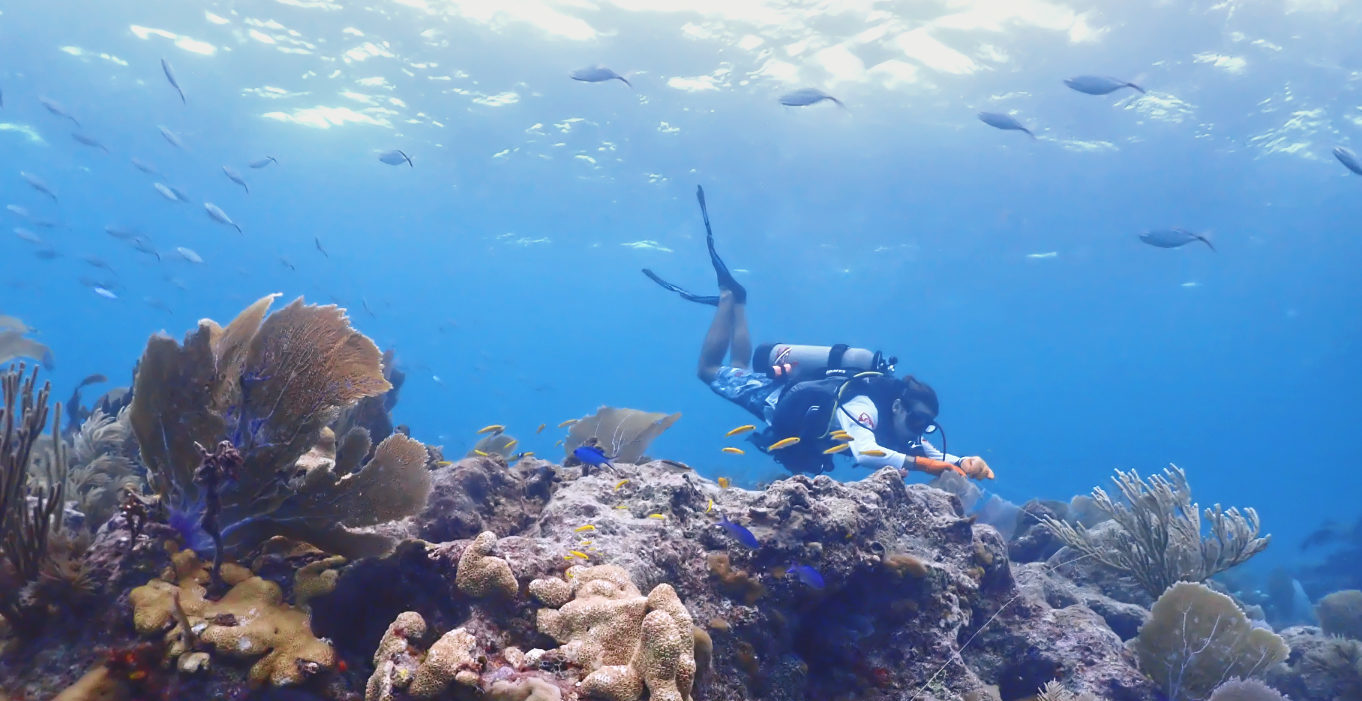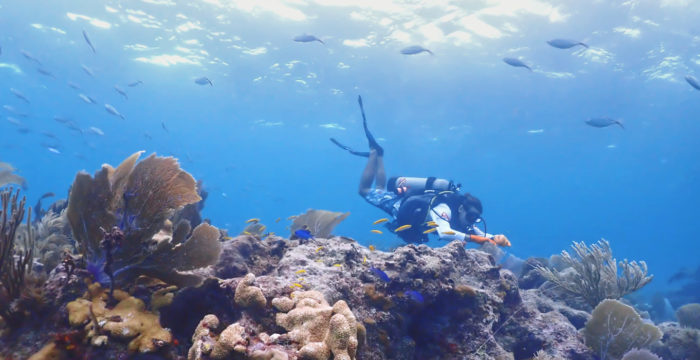
Support Stronger Protection and Restoration in the Florida Keys

Photo credit: Sean Davis
Florida Keys National Marine Sanctuary is a national treasure, safeguarding a complex, interconnected ecosystem with diverse habitats and wildlife. The Florida Keys’ marine ecosystem is home to more than 6,000 species of marine life; 800 underwater historic sites; and unique, and nationally significant marine environments including 1,800 miles of mangrove-fringed islands; 1.4 million acres of extensive seagrass beds; and the only coral barrier reef in the continental U.S. These ecosystems provide natural armoring against extreme events and storm surges, retain nutrients and control sediment erosion from land, act as carbon sinks, and serve as habitat and nurseries for fish and other species during vulnerable life stages. The sanctuary’s world-class diving, swimming, fishing, snorkeling, and other recreational opportunities attracts millions of visitors and brings the local economy more than $4.4 billion in annual revenue.
Unfortunately, the sanctuary’s habitats and the species that call them home are facing unprecedented stressors. Pressures from increasing coastal populations, marine debris, vessel groundings, climate change, sea level rise, and ocean acidification are large scale issues that are critically threatening the health of the Florida Keys ecosystem. Local impacts include increased vessel traffic, boat groundings and derelict and abandoned vessels, improper anchoring, marine debris, commercial and recreational fishing pressures, and wildlife disturbances.
A comprehensive, science-based approach and strong management plan are needed to protect and conserve the marine environment and allow future generations to continue to dive, fish, and boat in these precious waters. The proposed rule and draft management plan for Florida Key’s National Marine Sanctuary contain actions to address the threats to the sanctuary, restore habitats, and protect marine wildlife. We commend NOAA for recognizing the need to address these mounting threats to the marine environment through regulatory changes and an updated management plan. We need stronger, more robust protections to build resilient ecosystems and foster successful restoration.
However, NOAA should include additional actions in the final rule and management plan to provide the most protective measures possible to protect this ecological gem. To better protect habitats and biodiversity NOAA should include large, contiguous areas containing diverse habitat types and additional highly protected Conservation Areas in the final rule. Here are some specific recommendations from the National Marine Sanctuary Foundation that we hope NOAA will implement in the proposed Restoration Blueprint. YOU can speak up for our sanctuaries and help Save Our Florida Keys by signing our Take Action letter to tell NOAA you support stronger protections for Florida Keys National Marine Sanctuary and encourage them to include strong protections in the final rule and management plan.
- Fully protected, no-take areas protect habitats and biodiversity. We support the increase in the number of acres of the sanctuary that are strongly protected and encourage NOAA to include additional Conservation Areas in the final rule. Stronger protections that safeguard and bolster greater biodiversity and cover a network of interconnected habitats enhance the ability of ecosystems to respond to stressors by buffering impacts and supporting recovery afterwards. No-take zones can aid habitat recovery, fisheries productivity, and sustaining hot spots of biodiversity and wildlife richness both in the no-take zone and in adjacent waters. We support NOAA’s proposal to combine the existing Ecological Reserves and Special Use Areas into one Conservation Area zone type and to apply regulations prohibiting fishing, requiring continuous transit without interruption, and requiring stowage of gear in these areas. We also support the proposed expansion of Tennessee Reef, Western Sambo, and Tortugas South Conservation Areas to include additional important deep reef habitats and fish spawning aggregations. We urge NOAA to include Carysfort Reef, Long Key Tennessee Reef, and Tortugas Corridor Conservation Areas in the final rule to provide the greatest level of protection for habitats and species in these areas.
- We support NOAA’s proposal to include Pulley Ridge in the sanctuary and encourage the agency to strengthen the level of protection for high biodiversity areas, including expanding the proposed Western Dry Rocks seasonal closure to a year-round prohibition on anchoring. Pulley Ridge, the deepest known photosynthetic coral reef off the continental United States, is an important multiple species spawning ground, and a hotspot of biodiversity. Pulley Ridge is home to a variety of corals and more than 60 species of shallow and deep reef fish. Adding Pulley Ridge to the sanctuary will provide complementary and more comprehensive protections for this area of high biodiversity. We support the proposed regulation prohibiting all vessels from anchoring in Pulley Ridge which would eliminate the anchor and chain damage that is documented to occur there. We also support the proposed new no entry Pigeon Key Wildlife Management Area that will decrease disturbances to a highly sensitive bird nesting area and the Marquesas Turtle Wildlife Management Area which will decrease disturbance to endangered green sea turtles. Including Western Dry Rocks, an important multiple species spawning ground and a hotspot of biodiversity as a new Wildlife Management Area is a good first step.
- We need to protect larger areas. To further protect interconnected habitats and various stages of marine life, the final rule should include establishing large, contiguous areas containing diverse habitat types. Large, highly protected, contiguous areas containing diverse habitat types are the most effective way to preserve biodiversity and create resilience to climate change. Protecting specific habitats and zones will only protect wildlife during certain life phases. We urge NOAA to include establishing three large, contiguous Conservation Areas (Carysfort Reef, Long Key Tennessee Reef, and Tortugas Corridor) in the final rule. By connecting large areas, these Conservation Areas would connect existing protected areas with seagrass, shallow hard bottom, patch reefs, and deep reef habitats. A more comprehensive protected area will protect slower growing corals that provide a corridor for migration of different life stages of fish, juvenile fish nurseries, and spawning locations for fish and lobster. If these specific areas are not included in the final rule it is important to consider other appropriate areas for future protection as large contiguous marine zones.
- To better protect shallow areas of the sanctuary, we support expanding the existing idle speed/no wake zone along all residential shorelines to include 100 yards of all shorelines sanctuary wide except in marked and traditional channels and routes that do not conflict with natural resource and public safety protection. This should be included in the final rule. This is a commonsense approach to minimizing negative impacts on bottom and shoreline habitat, fish and bird populations, vessels, and user safety. While we are glad to see the proposed rule includes protecting several shallow areas, home to seagrass meadows and fish nurseries, with idle speed or no motor zones, these safeguards still leave too many shallow areas of the sanctuary at risk. We urge NOAA to adopt a sanctuary-wide regulation requiring idle speeds within 100 yards of all shorelines throughout the sanctuary, which would prevent seagrass and wildlife scars in these important habitats.
- Improving water quality is essential to maintaining biodiversity. We support NOAA’s proposal to prohibit cruise ships from discharging greywater and deck washdown within the sanctuary. Greywater contains harmful chemicals and bacteria that when dumped into the ocean can decrease oxygen levels, spread pathogenic bacteria and viruses, and increase nutrient levels in the surrounding ecosystem. Increased nutrient levels can cause harmful algae blooms that disturb food chains and further threaten coral reefs. Revising current discharge regulations that allow for greywater exceptions will help to safeguard the health of the sanctuary waters.
- Navigating Florida’s shallow waters is challenging and many boating practices can scar seagrass, damage coral, and harm wildlife. We support a mandatory boater education program, which would better balance public access with responsible use and resource protection. In 2019, NOAA released a voluntary program intended to educate boaters about relevant regulations that provide the framework for boater safety and resource protection in the sanctuary. Participation has been very limited despite efforts to encourage it. Given demonstrated damage to sensitive natural resources caused by uneducated boaters, we support making the boater education program mandatory for all those boating in sanctuary waters. Implementing this requirement would be pparticularly helpful to inform boaters of the newly updated sanctuary regulations.
TELL NOAA YOU SUPPORT STRONGER PROTECTIONS FOR FLORIDA KEYS NATIONAL MARINE SANCTUARY! Sign our Take Action letter today to encourage NOAA to include the above recommendations in the final rule and management plan.
